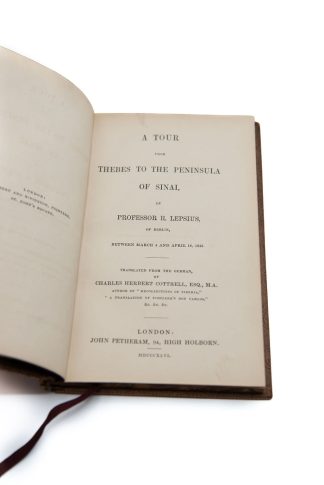LEPSIUS, Charles-Richard.
A tour from Thebes to the peninsula of Sinai
London, John Petheram, 1846.£350.00
FIRST EDITION thus. Small 8vo. pp. [7] 4-92 [2]. Roman letter. Armorial book plate of art collector and industrialist John Sheepshanks (1787-1863). Later French mss. in blue on ffep, providing a brief description of the book’s content, author’s background, and interests. In contemporary calf, gilt tooled border, rebacked, spine gilt, remounted.
A clean, crisp copy of the first edition in English of the initially unpublished pamphlet containing a progress report from the ‘founder of modern Egyptology’, Charles-Richard Lepsius (1810-1884), to King Federick Wilhelm IV of Prussia.
The travel account dates from 4th March until 14th April 1845. In the narrative, Lepsius travels from Thebes to Mount Sinai and describes the Egyptian landscape, geology, and wildlife, noting the excess of iron ore deposits around the temple of Hathor at Sar’but el Cha’dem, and also writes about the ancient copper mines. The French handwritten note at the beginning of the book mentions Lepsius’ personal interest in minerology, which is made manifest in his visitation of a variety of quarries, including marble, granite and porphyry.
Attention is given to three key historical aspects, namely the ‘primeval Egyptian colonies’ with their inscriptions and temples which ‘have attracted the admiration of travellers and given rise to the most extraordinary hypotheses’. Lepsius studies stelai and sketches sites, whose descriptions are included. He then turns to theories as to the purpose of the ancient ruins, analysing those put forward by other scholars, explorers and collectors like Lord Prudhoe (1792-1865), Eduard Rüppell (1794-1884), Edward Robinson (1794-1863) and Carsten Niehbur (1733-1815). Next is the identification of Biblical settings, which he attempts through the comparison of ‘statements with the present localities’ with the ‘journey of the Israelites through the wilderness’. Lepsius occasionally quotes the Bible, comparing the textual descriptions with the observable surrounding landscape, in an attempt to trace the exact journey of the Israelites through Sinai as they escaped Egypt. He concerns himself with the location of Mount Sinai and the ‘significancy and position of Horeb’. The third historical point is the briefly mentioned Sinaic inscriptions, which he describes as the ‘work of the Israelites’. An interesting monograph combining secular and Biblical archaeology.
See Blackmer Sale Cat. 781 for full official publication.In stock





